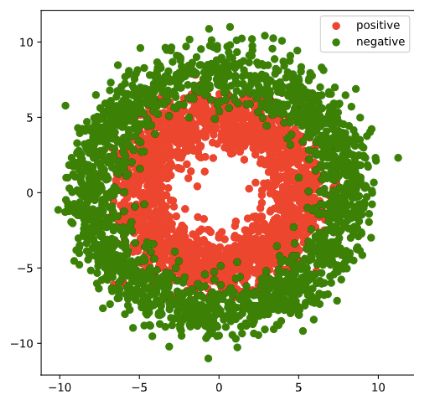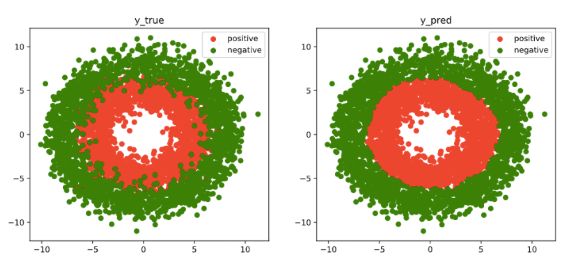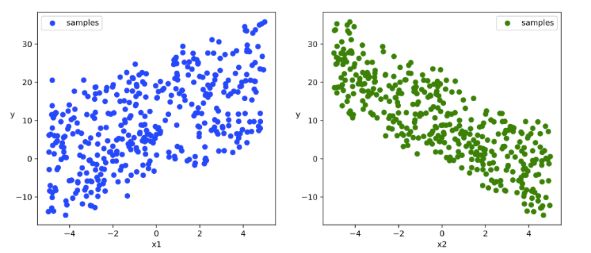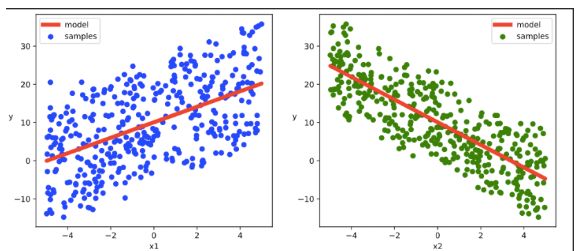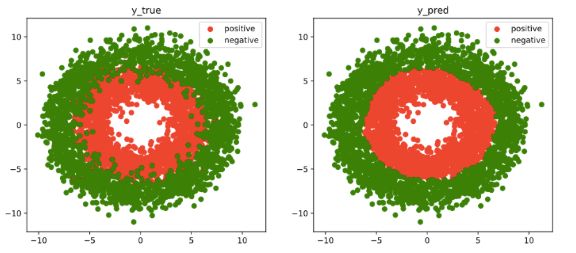pytroch、tensorflow对比学习—搭建模型范式(低阶、中阶、高阶API示例)
搭建模型范式(低阶、中阶、高阶API示例)
前言
本文是《pytorch-tensorflow-Comparative study》,pytorch和tensorflow对比学习专栏,第四章——搭建模型范式(低阶、中阶、高阶API示例)。
虽然说这两个框架在语法和接口的命名上有很多地方是不同的,但是深度学习的建模过程确实基本上都是一个套路的。
所以该笔记的笔记方式是:在使用相同的处理功能模块上,对比记录pytorch和tensorflow两者的API接口,和语法。

1,有利于深入理解深度学习建模过程流程。
2,有利于理解pytorch,和tensorflow设计上的不同,更加灵活的使用在自己的项目中。
3,有利于深入理解各个功能模块的使用。
本章节主要对比学习pytorch 和tensorflow有关搭建模型范式(低阶、中阶、高阶API示例)接口,和语法。
低阶API示例
这里范例使用Pytorch和tensorflow的低阶API分别实现线性回归模型和DNN二分类模型。
低阶API主要包括张量操作,计算图和自动微分。
先定义打印时间函数(在中介和高阶API示例中都会使用到):
pytorch
import os
import datetime
#打印时间
def printbar():
nowtime = datetime.datetime.now().strftime('%Y-%m-%d %H:%M:%S')
print("\n"+"=========="*8 + "%s"%nowtime)
#mac系统上pytorch和matplotlib在jupyter中同时跑需要更改环境变量
os.environ["KMP_DUPLICATE_LIB_OK"]="TRUE"
tensorflow
import tensorflow as tf
#打印时间分割线
@tf.function
def printbar():
today_ts = tf.timestamp()%(24*60*60)
hour = tf.cast(today_ts//3600+8,tf.int32)%tf.constant(24)
minite = tf.cast((today_ts%3600)//60,tf.int32)
second = tf.cast(tf.floor(today_ts%60),tf.int32)
def timeformat(m):
if tf.strings.length(tf.strings.format("{}",m))==1:
return(tf.strings.format("0{}",m))
else:
return(tf.strings.format("{}",m))
timestring = tf.strings.join([timeformat(hour),timeformat(minite),
timeformat(second)],separator = ":")
tf.print("=========="*8+timestring)
线性回归模型
准备数据
pytorch
import numpy as np
import pandas as pd
from matplotlib import pyplot as plt
import torch
from torch import nn
#样本数量
n = 400
# 生成测试用数据集
X = 10*torch.rand([n,2])-5.0 #torch.rand是均匀分布
w0 = torch.tensor([[2.0],[-3.0]])
b0 = torch.tensor([[10.0]])
Y = X@w0 + b0 + torch.normal( 0.0,2.0,size = [n,1]) # @表示矩阵乘法,增加正态扰动
# 数据可视化
plt.figure(figsize = (12,5))
ax1 = plt.subplot(121)
ax1.scatter(X[:,0].numpy(),Y[:,0].numpy(), c = "b",label = "samples")
ax1.legend()
plt.xlabel("x1")
plt.ylabel("y",rotation = 0)
ax2 = plt.subplot(122)
ax2.scatter(X[:,1].numpy(),Y[:,0].numpy(), c = "g",label = "samples")
ax2.legend()
plt.xlabel("x2")
plt.ylabel("y",rotation = 0)
plt.show()
tensorflow
import numpy as np
import pandas as pd
from matplotlib import pyplot as plt
import tensorflow as tf
#样本数量
n = 400
# 生成测试用数据集
X = tf.random.uniform([n,2],minval=-10,maxval=10)
w0 = tf.constant([[2.0],[-3.0]])
b0 = tf.constant([[3.0]])
Y = X@w0 + b0 + tf.random.normal([n,1],mean = 0.0,stddev= 2.0) # @表示矩阵乘法,增加正态扰动
# 数据可视化
plt.figure(figsize = (12,5))
ax1 = plt.subplot(121)
ax1.scatter(X[:,0],Y[:,0], c = "b")
plt.xlabel("x1")
plt.ylabel("y",rotation = 0)
ax2 = plt.subplot(122)
ax2.scatter(X[:,1],Y[:,0], c = "g")
plt.xlabel("x2")
plt.ylabel("y",rotation = 0)
plt.show()
数据管道
pytroch
# 构建数据管道迭代器
def data_iter(features, labels, batch_size=8):
num_examples = len(features)
indices = list(range(num_examples))
np.random.shuffle(indices) #样本的读取顺序是随机的
for i in range(0, num_examples, batch_size):
indexs = torch.LongTensor(indices[i: min(i + batch_size, num_examples)])
yield features.index_select(0, indexs), labels.index_select(0, indexs)
# 测试数据管道效果
batch_size = 8
(features,labels) = next(data_iter(X,Y,batch_size))
print(features)
print(labels)
# tensor([[-4.3880, 1.3655],
# [-0.1082, 3.9533],
# [-2.6286, 2.7058],
# [ 1.0604, -1.8646],
# [-1.5805, 1.5406],
# [-2.6217, -3.2342],
# [ 2.3748, -0.6449],
# [-1.2478, -2.0509]])
# tensor([[-0.2069],
# [-3.2494],
# [-6.9620],
# [17.0528],
# [ 1.1076],
# [17.2117],
# [16.1081],
# [14.7092]])
tensorflow
# 构建数据管道迭代器
def data_iter(features, labels, batch_size=8):
num_examples = len(features)
indices = list(range(num_examples))
np.random.shuffle(indices) #样本的读取顺序是随机的
for i in range(0, num_examples, batch_size):
indexs = indices[i: min(i + batch_size, num_examples)]
yield tf.gather(features,indexs), tf.gather(labels,indexs)
# 测试数据管道效果
batch_size = 8
(features,labels) = next(data_iter(X,Y,batch_size))
print(features)
print(labels)
# tf.Tensor(
# [[ 2.6161194 0.11071014]
# [ 9.79207 -0.70180416]
# [ 9.792343 6.9149055 ]
# [-2.4186516 -9.375019 ]
# [ 9.83749 -3.4637213 ]
# [ 7.3953056 4.374569 ]
# [-0.14686584 -0.28063297]
# [ 0.49001217 -9.739792 ]], shape=(8, 2), dtype=float32)
# tf.Tensor(
# [[ 9.334667 ]
# [22.058844 ]
# [ 3.0695205]
# [26.736238 ]
# [35.292133 ]
# [ 4.2943544]
# [ 1.6713585]
# [34.826904 ]], shape=(8, 1), dtype=float32)
定义模型
pytorch
# 定义模型
class LinearRegression:
def __init__(self):
self.w = torch.randn_like(w0,requires_grad=True)
self.b = torch.zeros_like(b0,requires_grad=True)
#正向传播
def forward(self,x):
return x@self.w + self.b
# 损失函数
def loss_func(self,y_pred,y_true):
return torch.mean((y_pred - y_true)**2/2)
model = LinearRegression()
tensorflow
w = tf.Variable(tf.random.normal(w0.shape))
b = tf.Variable(tf.zeros_like(b0,dtype = tf.float32))
# 定义模型
class LinearRegression:
#正向传播
def __call__(self,x):
return x@w + b
# 损失函数
def loss_func(self,y_true,y_pred):
return tf.reduce_mean((y_true - y_pred)**2/2)
model = LinearRegression()
训练模型
def train_step(model, features, labels):
predictions = model.forward(features)
loss = model.loss_func(predictions,labels)
# 反向传播求梯度
loss.backward()
# 使用torch.no_grad()避免梯度记录,也可以通过操作 model.w.data 实现避免梯度记录
with torch.no_grad():
# 梯度下降法更新参数
model.w -= 0.001*model.w.grad
model.b -= 0.001*model.b.grad
# 梯度清零
model.w.grad.zero_()
model.b.grad.zero_()
return loss
# 测试train_step效果
batch_size = 10
(features,labels) = next(data_iter(X,Y,batch_size))
train_step(model,features,labels)
# tensor(92.8199, grad_fn=)
def train_model(model,epochs):
for epoch in range(1,epochs+1):
for features, labels in data_iter(X,Y,10):
loss = train_step(model,features,labels)
if epoch%200==0:
printbar()
print("epoch =",epoch,"loss = ",loss.item())
print("model.w =",model.w.data)
print("model.b =",model.b.data)
train_model(model,epochs = 1000)
# ================================================================================2020-07-05 08:27:57
# epoch = 200 loss = 2.6340413093566895
# model.w = tensor([[ 2.0283],
# [-2.9632]])
# model.b = tensor([[10.0748]])
#
# ================================================================================2020-07-05 08:28:00
# epoch = 400 loss = 2.24908709526062
# model.w = tensor([[ 2.0300],
# [-2.9643]])
# model.b = tensor([[10.0781]])#
# ....
tensorflow
'''
##使用autograph机制转换成静态图加速
@tf.function
'''
# 使用动态图调试
def train_step(model, features, labels):
with tf.GradientTape() as tape:
predictions = model(features)
loss = model.loss_func(labels, predictions)
# 反向传播求梯度
dloss_dw,dloss_db = tape.gradient(loss,[w,b])
# 梯度下降法更新参数
w.assign(w - 0.001*dloss_dw)
b.assign(b - 0.001*dloss_db)
return loss
# 测试train_step效果
batch_size = 10
(features,labels) = next(data_iter(X,Y,batch_size))
train_step(model,features,labels)
# def train_model(model,epochs):
for epoch in tf.range(1,epochs+1):
for features, labels in data_iter(X,Y,10):
loss = train_step(model,features,labels)
if epoch%50==0:
printbar()
tf.print("epoch =",epoch,"loss = ",loss)
tf.print("w =",w)
tf.print("b =",b)
train_model(model,epochs = 200)
# ================================================================================16:35:56
# epoch = 50 loss = 1.78806472
# w = [[1.97554708]
# [-2.97719598]]
# b = [[2.60692883]]
# ================================================================================16:36:00
# epoch = 100 loss = 2.64588404
# w = [[1.97319281]
# [-2.97810626]]
# b = [[2.95525956]]
# ...
结果可视化
# 结果可视化
plt.figure(figsize = (12,5))
ax1 = plt.subplot(121)
ax1.scatter(X[:,0].numpy(),Y[:,0].numpy(), c = "b",label = "samples")
ax1.plot(X[:,0].numpy(),(model.w[0].data*X[:,0]+model.b[0].data).numpy(),"-r",linewidth = 5.0,label = "model")
ax1.legend()
plt.xlabel("x1")
plt.ylabel("y",rotation = 0)
ax2 = plt.subplot(122)
ax2.scatter(X[:,1].numpy(),Y[:,0].numpy(), c = "g",label = "samples")
ax2.plot(X[:,1].numpy(),(model.w[1].data*X[:,1]+model.b[0].data).numpy(),"-r",linewidth = 5.0,label = "model")
ax2.legend()
plt.xlabel("x2")
plt.ylabel("y",rotation = 0)
plt.show()
DNN二分类模型
准备数据
pytorch
import numpy as np
import pandas as pd
from matplotlib import pyplot as plt
import torch
from torch import nn
%matplotlib inline
%config InlineBackend.figure_format = 'svg'
#正负样本数量
n_positive,n_negative = 2000,2000
#生成正样本, 小圆环分布
r_p = 5.0 + torch.normal(0.0,1.0,size = [n_positive,1])
theta_p = 2*np.pi*torch.rand([n_positive,1])
Xp = torch.cat([r_p*torch.cos(theta_p),r_p*torch.sin(theta_p)],axis = 1)
Yp = torch.ones_like(r_p)
#生成负样本, 大圆环分布
r_n = 8.0 + torch.normal(0.0,1.0,size = [n_negative,1])
theta_n = 2*np.pi*torch.rand([n_negative,1])
Xn = torch.cat([r_n*torch.cos(theta_n),r_n*torch.sin(theta_n)],axis = 1)
Yn = torch.zeros_like(r_n)
#汇总样本
X = torch.cat([Xp,Xn],axis = 0)
Y = torch.cat([Yp,Yn],axis = 0)
#可视化
plt.figure(figsize = (6,6))
plt.scatter(Xp[:,0].numpy(),Xp[:,1].numpy(),c = "r")
plt.scatter(Xn[:,0].numpy(),Xn[:,1].numpy(),c = "g")
plt.legend(["positive","negative"]);
tensorflow
import numpy as np
import pandas as pd
from matplotlib import pyplot as plt
import tensorflow as tf
%matplotlib inline
%config InlineBackend.figure_format = 'svg'
#正负样本数量
n_positive,n_negative = 2000,2000
#生成正样本, 小圆环分布
r_p = 5.0 + tf.random.truncated_normal([n_positive,1],0.0,1.0)
theta_p = tf.random.uniform([n_positive,1],0.0,2*np.pi)
Xp = tf.concat([r_p*tf.cos(theta_p),r_p*tf.sin(theta_p)],axis = 1)
Yp = tf.ones_like(r_p)
#生成负样本, 大圆环分布
r_n = 8.0 + tf.random.truncated_normal([n_negative,1],0.0,1.0)
theta_n = tf.random.uniform([n_negative,1],0.0,2*np.pi)
Xn = tf.concat([r_n*tf.cos(theta_n),r_n*tf.sin(theta_n)],axis = 1)
Yn = tf.zeros_like(r_n)
#汇总样本
X = tf.concat([Xp,Xn],axis = 0)
Y = tf.concat([Yp,Yn],axis = 0)
#可视化
plt.figure(figsize = (6,6))
plt.scatter(Xp[:,0].numpy(),Xp[:,1].numpy(),c = "r")
plt.scatter(Xn[:,0].numpy(),Xn[:,1].numpy(),c = "g")
plt.legend(["positive","negative"]);
数据管道
pytorch
# 构建数据管道迭代器
def data_iter(features, labels, batch_size=8):
num_examples = len(features)
indices = list(range(num_examples))
np.random.shuffle(indices) #样本的读取顺序是随机的
for i in range(0, num_examples, batch_size):
indexs = torch.LongTensor(indices[i: min(i + batch_size, num_examples)])
yield features.index_select(0, indexs), labels.index_select(0, indexs)
# 测试数据管道效果
batch_size = 8
(features,labels) = next(data_iter(X,Y,batch_size))
print(features)
print(labels)
# tensor([[ 6.9914, -1.0820],
# [ 4.8156, 4.0532],
# [-1.0697, -7.4644],
# [ 2.6291, 3.8851],
# [-1.6780, -4.3390],
# [-6.1495, 1.2269],
# [-4.3422, 3.9552],
# [-6.2265, 2.6159]])
# tensor([[0.],
# [1.],
# [0.],
# [1.],
# [1.],
# [1.],
# [1.],
# [1.]])
tensorflow
# 构建数据管道迭代器
def data_iter(features, labels, batch_size=8):
num_examples = len(features)
indices = list(range(num_examples))
np.random.shuffle(indices) #样本的读取顺序是随机的
for i in range(0, num_examples, batch_size):
indexs = indices[i: min(i + batch_size, num_examples)]
yield tf.gather(features,indexs), tf.gather(labels,indexs)
# 测试数据管道效果
batch_size = 10
(features,labels) = next(data_iter(X,Y,batch_size))
print(features)
print(labels)
# tf.Tensor(
# [[ 0.03732629 3.5783494 ]
# [ 0.542919 5.035079 ]
# [ 5.860281 -2.4476354 ]
# [ 0.63657564 3.194231 ]
# [-3.5072308 2.5578873 ]
# [-2.4109735 -3.6621518 ]
# [ 4.0975413 -2.4172943 ]
# [ 1.9393908 -6.782317 ]
# [-4.7453732 -0.5176727 ]
# [-1.4057113 -7.9775257 ]], shape=(10, 2), dtype=float32)
# tf.Tensor(
# [[1.]
# [1.]
# [0.]
# [1.]
# [1.]
# [1.]
# [1.]
# [0.]
# [1.]
# [0.]], shape=(10, 1), dtype=float32)
定义模型
pythorch
此处范例我们利用nn.Module来组织模型变量。
class DNNModel(nn.Module):
def __init__(self):
super(DNNModel, self).__init__()
self.w1 = nn.Parameter(torch.randn(2,4))
self.b1 = nn.Parameter(torch.zeros(1,4))
self.w2 = nn.Parameter(torch.randn(4,8))
self.b2 = nn.Parameter(torch.zeros(1,8))
self.w3 = nn.Parameter(torch.randn(8,1))
self.b3 = nn.Parameter(torch.zeros(1,1))
# 正向传播
def forward(self,x):
x = torch.relu(x@self.w1 + self.b1)
x = torch.relu(x@self.w2 + self.b2)
y = torch.sigmoid(x@self.w3 + self.b3)
return y
# 损失函数(二元交叉熵)
def loss_func(self,y_pred,y_true):
#将预测值限制在1e-7以上, 1- (1e-7)以下,避免log(0)错误
eps = 1e-7
y_pred = torch.clamp(y_pred,eps,1.0-eps)
bce = - y_true*torch.log(y_pred) - (1-y_true)*torch.log(1-y_pred)
return torch.mean(bce)
# 评估指标(准确率)
def metric_func(self,y_pred,y_true):
y_pred = torch.where(y_pred>0.5,torch.ones_like(y_pred,dtype = torch.float32),
torch.zeros_like(y_pred,dtype = torch.float32))
acc = torch.mean(1-torch.abs(y_true-y_pred))
return acc
model = DNNModel()
# 测试模型结构
batch_size = 10
(features,labels) = next(data_iter(X,Y,batch_size))
predictions = model(features)
loss = model.loss_func(labels,predictions)
metric = model.metric_func(labels,predictions)
print("init loss:", loss.item())
print("init metric:", metric.item())
# init loss: 7.979694366455078
# init metric: 0.50347900390625
len(list(model.parameters()))
# 6
tensorflow
此处范例我们利用tf.Module来组织模型变量,关于tf.Module的较详细介绍参考本书第四章最后一节: Autograph和tf.Module。
class DNNModel(tf.Module):
def __init__(self,name = None):
super(DNNModel, self).__init__(name=name)
self.w1 = tf.Variable(tf.random.truncated_normal([2,4]),dtype = tf.float32)
self.b1 = tf.Variable(tf.zeros([1,4]),dtype = tf.float32)
self.w2 = tf.Variable(tf.random.truncated_normal([4,8]),dtype = tf.float32)
self.b2 = tf.Variable(tf.zeros([1,8]),dtype = tf.float32)
self.w3 = tf.Variable(tf.random.truncated_normal([8,1]),dtype = tf.float32)
self.b3 = tf.Variable(tf.zeros([1,1]),dtype = tf.float32)
# 正向传播
@tf.function(input_signature=[tf.TensorSpec(shape = [None,2], dtype = tf.float32)])
def __call__(self,x):
x = tf.nn.relu(x@self.w1 + self.b1)
x = tf.nn.relu(x@self.w2 + self.b2)
y = tf.nn.sigmoid(x@self.w3 + self.b3)
return y
# 损失函数(二元交叉熵)
@tf.function(input_signature=[tf.TensorSpec(shape = [None,1], dtype = tf.float32),
tf.TensorSpec(shape = [None,1], dtype = tf.float32)])
def loss_func(self,y_true,y_pred):
#将预测值限制在 1e-7 以上, 1 - 1e-7 以下,避免log(0)错误
eps = 1e-7
y_pred = tf.clip_by_value(y_pred,eps,1.0-eps)
bce = - y_true*tf.math.log(y_pred) - (1-y_true)*tf.math.log(1-y_pred)
return tf.reduce_mean(bce)
# 评估指标(准确率)
@tf.function(input_signature=[tf.TensorSpec(shape = [None,1], dtype = tf.float32),
tf.TensorSpec(shape = [None,1], dtype = tf.float32)])
def metric_func(self,y_true,y_pred):
y_pred = tf.where(y_pred>0.5,tf.ones_like(y_pred,dtype = tf.float32),
tf.zeros_like(y_pred,dtype = tf.float32))
acc = tf.reduce_mean(1-tf.abs(y_true-y_pred))
return acc
model = DNNModel()
# 测试模型结构
batch_size = 10
(features,labels) = next(data_iter(X,Y,batch_size))
predictions = model(features)
loss = model.loss_func(labels,predictions)
metric = model.metric_func(labels,predictions)
tf.print("init loss:",loss)
tf.print("init metric",metric)
# init loss: 1.76568353
# init metric 0.6
print(len(model.trainable_variables))
# 6
训练模型
pytorch
def train_step(model, features, labels):
# 正向传播求损失
predictions = model.forward(features)
loss = model.loss_func(predictions,labels)
metric = model.metric_func(predictions,labels)
# 反向传播求梯度
loss.backward()
# 梯度下降法更新参数
for param in model.parameters():
#注意是对param.data进行重新赋值,避免此处操作引起梯度记录
param.data = (param.data - 0.01*param.grad.data)
# 梯度清零
model.zero_grad()
return loss.item(),metric.item()
def train_model(model,epochs):
for epoch in range(1,epochs+1):
loss_list,metric_list = [],[]
for features, labels in data_iter(X,Y,20):
lossi,metrici = train_step(model,features,labels)
loss_list.append(lossi)
metric_list.append(metrici)
loss = np.mean(loss_list)
metric = np.mean(metric_list)
if epoch%100==0:
printbar()
print("epoch =",epoch,"loss = ",loss,"metric = ",metric)
train_model(model,epochs = 1000)
# ================================================================================2020-07-05 08:32:16
# epoch = 100 loss = 0.24841043589636683 metric = 0.8944999960064888
#
# ================================================================================2020-07-05 08:32:34
# epoch = 200 loss = 0.20398724960163236 metric = 0.920999992787838
#
# ================================================================================2020-07-05 08:32:54
# epoch = 300 loss = 0.19509393003769218 metric = 0.9239999914169311
#
# ================================================================================2020-07-05 08:33:14
# ...
tensorflow
##使用autograph机制转换成静态图加速
@tf.function
def train_step(model, features, labels):
# 正向传播求损失
with tf.GradientTape() as tape:
predictions = model(features)
loss = model.loss_func(labels, predictions)
# 反向传播求梯度
grads = tape.gradient(loss, model.trainable_variables)
# 执行梯度下降
for p, dloss_dp in zip(model.trainable_variables,grads):
p.assign(p - 0.001*dloss_dp)
# 计算评估指标
metric = model.metric_func(labels,predictions)
return loss, metric
def train_model(model,epochs):
for epoch in tf.range(1,epochs+1):
for features, labels in data_iter(X,Y,100):
loss,metric = train_step(model,features,labels)
if epoch%100==0:
printbar()
tf.print("epoch =",epoch,"loss = ",loss, "accuracy = ", metric)
train_model(model,epochs = 600)
# ================================================================================16:47:35
# epoch = 100 loss = 0.567795336 accuracy = 0.71
# ================================================================================16:47:39
# epoch = 200 loss = 0.50955683 accuracy = 0.77
# ================================================================================16:47:43
# epoch = 300 loss = 0.421476126 accuracy = 0.84
结果可视化
fig, (ax1,ax2) = plt.subplots(nrows=1,ncols=2,figsize = (12,5))
ax1.scatter(Xp[:,0],Xp[:,1], c="r")
ax1.scatter(Xn[:,0],Xn[:,1],c = "g")
ax1.legend(["positive","negative"]);
ax1.set_title("y_true");
Xp_pred = X[torch.squeeze(model.forward(X)>=0.5)]
Xn_pred = X[torch.squeeze(model.forward(X)<0.5)]
ax2.scatter(Xp_pred[:,0],Xp_pred[:,1],c = "r")
ax2.scatter(Xn_pred[:,0],Xn_pred[:,1],c = "g")
ax2.legend(["positive","negative"]);
ax2.set_title("y_pred");
中介API示例
Pytorch的中阶API主要包括各种模型层,损失函数,优化器,数据管道等等。
TensorFlow的中阶API主要包括各种模型层,损失函数,优化器,数据管道,特征列等等。
线性回归模型
准备数据
pytroch和tensorflow 的数据准备和低阶API部分相同,使用相同的数据,可以直接把代码粘过来,这里不做重复。
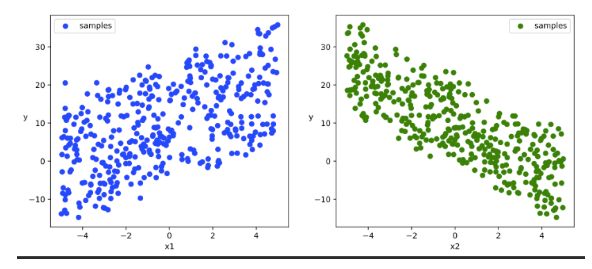
数据管道
pytroch
#构建输入数据管道
ds = TensorDataset(X,Y)
dl = DataLoader(ds,batch_size = 10,shuffle=True,num_workers=2)
tensorflow
#构建输入数据管道
ds = tf.data.Dataset.from_tensor_slices((X,Y)) \
.shuffle(buffer_size = 100).batch(10) \
.prefetch(tf.data.experimental.AUTOTUNE)
定义模型
pytroch
model = nn.Linear(2,1) #线性层
model.loss_func = nn.MSELoss()
model.optimizer = torch.optim.SGD(model.parameters(),lr = 0.01)
tensorflow
model = layers.Dense(units = 1)
model.build(input_shape = (2,)) #用build方法创建variables
model.loss_func = losses.mean_squared_error
model.optimizer = optimizers.SGD(learning_rate=0.001)
训练模型
pytorch
def train_step(model, features, labels):
predictions = model(features)
loss = model.loss_func(predictions,labels)
loss.backward()
model.optimizer.step()
model.optimizer.zero_grad()
return loss.item()
# 测试train_step效果
features,labels = next(iter(dl))
train_step(model,features,labels)
# 269.98016357421875
def train_model(model,epochs):
for epoch in range(1,epochs+1):
for features, labels in dl:
loss = train_step(model,features,labels)
if epoch%50==0:
printbar()
w = model.state_dict()["weight"]
b = model.state_dict()["bias"]
print("epoch =",epoch,"loss = ",loss)
print("w =",w)
print("b =",b)
train_model(model,epochs = 200)
# ================================================================================2020-07-05 22:51:53
# epoch = 50 loss = 3.0177409648895264
# w = tensor([[ 1.9315, -2.9573]])
# b = tensor([9.9625])
#
# ================================================================================2020-07-05 22:51:57
# epoch = 100 loss = 2.1144354343414307
# w = tensor([[ 1.9760, -2.9398]])
# b = tensor([9.9428])
# ...
tensorflow
#使用autograph机制转换成静态图加速
@tf.function
def train_step(model, features, labels):
with tf.GradientTape() as tape:
predictions = model(features)
loss = model.loss_func(tf.reshape(labels,[-1]), tf.reshape(predictions,[-1]))
grads = tape.gradient(loss,model.variables)
model.optimizer.apply_gradients(zip(grads,model.variables))
return loss
# 测试train_step效果
features,labels = next(ds.as_numpy_iterator())
train_step(model,features,labels)
def train_model(model,epochs):
for epoch in tf.range(1,epochs+1):
loss = tf.constant(0.0)
for features, labels in ds:
loss = train_step(model,features,labels)
if epoch%50==0:
printbar()
tf.print("epoch =",epoch,"loss = ",loss)
tf.print("w =",model.variables[0])
tf.print("b =",model.variables[1])
train_model(model,epochs = 200)
# ===========================================================================17:01:48
# epoch = 50 loss = 2.56481647
# w = [[1.99355531]
# [-2.99061537]]
# b = [3.09484935]
# ===========================================================================17:01:51
# epoch = 100 loss = 5.96198225
# w = [[1.98028314]
# [-2.96975136]]
# b = [3.09501529]
# ...
结果可视化
DNN二分类模型
准备数据
pytroch和tensorflow 的数据准备和低阶API部分相同,使用相同的数据,可以直接把代码粘过来,这里不做重复。

数据管道
pytorch
#构建输入数据管道
ds = TensorDataset(X,Y)
dl = DataLoader(ds,batch_size = 10,shuffle=True,num_workers=2)
tensorflow
#构建输入数据管道
ds = tf.data.Dataset.from_tensor_slices((X,Y)) \
.shuffle(buffer_size = 4000).batch(100) \
.prefetch(tf.data.experimental.AUTOTUNE)
定义模型
pytroch
class DNNModel(nn.Module):
def __init__(self):
super(DNNModel, self).__init__()
self.fc1 = nn.Linear(2,4)
self.fc2 = nn.Linear(4,8)
self.fc3 = nn.Linear(8,1)
# 正向传播
def forward(self,x):
x = F.relu(self.fc1(x))
x = F.relu(self.fc2(x))
y = nn.Sigmoid()(self.fc3(x))
return y
# 损失函数
def loss_func(self,y_pred,y_true):
return nn.BCELoss()(y_pred,y_true)
# 评估函数(准确率)
def metric_func(self,y_pred,y_true):
y_pred = torch.where(y_pred>0.5,torch.ones_like(y_pred,dtype = torch.float32),
torch.zeros_like(y_pred,dtype = torch.float32))
acc = torch.mean(1-torch.abs(y_true-y_pred))
return acc
# 优化器
@property
def optimizer(self):
return torch.optim.Adam(self.parameters(),lr = 0.001)
model = DNNModel()
# 测试模型结构
(features,labels) = next(iter(dl))
predictions = model(features)
loss = model.loss_func(predictions,labels)
metric = model.metric_func(predictions,labels)
print("init loss:",loss.item())
print("init metric:",metric.item())
# init loss: 0.7065666913986206
# init metric: 0.6000000238418579
tensorflow
class DNNModel(tf.Module):
def __init__(self,name = None):
super(DNNModel, self).__init__(name=name)
self.dense1 = layers.Dense(4,activation = "relu")
self.dense2 = layers.Dense(8,activation = "relu")
self.dense3 = layers.Dense(1,activation = "sigmoid")
# 正向传播
@tf.function(input_signature=[tf.TensorSpec(shape = [None,2], dtype = tf.float32)])
def __call__(self,x):
x = self.dense1(x)
x = self.dense2(x)
y = self.dense3(x)
return y
model = DNNModel()
model.loss_func = losses.binary_crossentropy
model.metric_func = metrics.binary_accuracy
model.optimizer = optimizers.Adam(learning_rate=0.001)
# 测试模型结构
(features,labels) = next(ds.as_numpy_iterator())
predictions = model(features)
loss = model.loss_func(tf.reshape(labels,[-1]),tf.reshape(predictions,[-1]))
metric = model.metric_func(tf.reshape(labels,[-1]),tf.reshape(predictions,[-1]))
tf.print("init loss:",loss)
tf.print("init metric",metric)
# init loss: 1.13653195
# init metric 0.5
训练模型
pytroch
def train_step(model, features, labels):
# 正向传播求损失
predictions = model(features)
loss = model.loss_func(predictions,labels)
metric = model.metric_func(predictions,labels)
# 反向传播求梯度
loss.backward()
# 更新模型参数
model.optimizer.step()
model.optimizer.zero_grad()
return loss.item(),metric.item()
# 测试train_step效果
features,labels = next(iter(dl))
train_step(model,features,labels)
# (0.6048880815505981, 0.699999988079071)
def train_model(model,epochs):
for epoch in range(1,epochs+1):
loss_list,metric_list = [],[]
for features, labels in dl:
lossi,metrici = train_step(model,features,labels)
loss_list.append(lossi)
metric_list.append(metrici)
loss = np.mean(loss_list)
metric = np.mean(metric_list)
if epoch%100==0:
printbar()
print("epoch =",epoch,"loss = ",loss,"metric = ",metric)
train_model(model,epochs = 300)
# ==============================================================2020-07-05 22:56:38
# epoch = 100 loss = 0.23532892110607917 metric = 0.934749992787838
#
# ==============================================================2020-07-05 22:58:18
# epoch = 200 loss = 0.24743918558603128 metric = 0.934999993443489
tensorflow
#使用autograph机制转换成静态图加速
@tf.function
def train_step(model, features, labels):
with tf.GradientTape() as tape:
predictions = model(features)
loss = model.loss_func(tf.reshape(labels,[-1]), tf.reshape(predictions,[-1]))
grads = tape.gradient(loss,model.trainable_variables)
model.optimizer.apply_gradients(zip(grads,model.trainable_variables))
metric = model.metric_func(tf.reshape(labels,[-1]), tf.reshape(predictions,[-1]))
return loss,metric
# 测试train_step效果
features,labels = next(ds.as_numpy_iterator())
train_step(model,features,labels)
# (,
# )
def train_model(model,epochs):
for epoch in tf.range(1,epochs+1):
loss, metric = tf.constant(0.0),tf.constant(0.0)
for features, labels in ds:
loss,metric = train_step(model,features,labels)
if epoch%10==0:
printbar()
tf.print("epoch =",epoch,"loss = ",loss, "accuracy = ",metric)
train_model(model,epochs = 60)
# ========================================================================17:07:36
# epoch = 10 loss = 0.556449413 accuracy = 0.79
# ========================================================================17:07:38
# epoch = 20 loss = 0.439187407 accuracy = 0.86
# ...
结果可视化
高阶API示例
TensorFlow的高阶API主要为tf.keras.models提供的模型的类接口。
使用Keras接口有以下3种方式构建模型:使用Sequential按层顺序构建模型,使用函数式API构建任意结构模型,继承Model基类构建自定义模型。
此处分别演示使用Sequential按层顺序构建模型以及继承Model基类构建自定义模型。
Pytorch没有官方的高阶API,一般需要用户自己实现训练循环、验证循环、和预测循环。
不过有大神通过仿照tf.keras.Model的功能对Pytorch的nn.Module进行了封装,设计了torchkeras.Model类,
实现了 fit, validate,predict, summary 方法,相当于用户自定义高阶API。
并示范了用它实现线性回归模型。
此外,还通过借用pytorch_lightning的功能,封装了类Keras接口的另外一种实现,即torchkeras.LightModel类。
pytorch
此范例我们通过继承torchkeras.Model模型接口,实现线性回归模型。
tensorflow
此范例我们使用Sequential按层顺序构建模型,并使用内置model.fit方法训练模型【面向新手】。
线性回归模型
准备数据
数据管道
pytroch
#构建输入数据管道
ds = TensorDataset(X,Y)
ds_train,ds_valid = torch.utils.data.random_split(ds,[int(400*0.7),400-int(400*0.7)])
dl_train = DataLoader(ds_train,batch_size = 10,shuffle=True,num_workers=2)
dl_valid = DataLoader(ds_valid,batch_size = 10,num_workers=2)
tensorflow
数据管道的构建继承在高阶API训练阶段的参数上
定义模型
pytorch
# 继承用户自定义模型
from torchkeras import Model
class LinearRegression(Model):
def __init__(self):
super(LinearRegression, self).__init__()
self.fc = nn.Linear(2,1)
def forward(self,x):
return self.fc(x)
model = LinearRegression()
model.summary(input_shape = (2,))
"""
----------------------------------------------------------------
Layer (type) Output Shape Param #
================================================================
Linear-1 [-1, 1] 3
================================================================
Total params: 3
Trainable params: 3
Non-trainable params: 0
----------------------------------------------------------------
Input size (MB): 0.000008
Forward/backward pass size (MB): 0.000008
Params size (MB): 0.000011
Estimated Total Size (MB): 0.000027
----------------------------------------------------------------
"""
tensorflow
tf.keras.backend.clear_session()
model = models.Sequential()
model.add(layers.Dense(1,input_shape =(2,)))
model.summary()
""""
Model: "sequential"
_________________________________________________________________
Layer (type) Output Shape Param #
=================================================================
dense (Dense) (None, 1) 3
=================================================================
Total params: 3
Trainable params: 3
Non-trainable params: 0
"""
训练模型
pytroch
### 使用fit方法进行训练
def mean_absolute_error(y_pred,y_true):
return torch.mean(torch.abs(y_pred-y_true))
def mean_absolute_percent_error(y_pred,y_true):
absolute_percent_error = (torch.abs(y_pred-y_true)+1e-7)/(torch.abs(y_true)+1e-7)
return torch.mean(absolute_percent_error)
model.compile(loss_func = nn.MSELoss(),
optimizer= torch.optim.Adam(model.parameters(),lr = 0.01),
metrics_dict={"mae":mean_absolute_error,"mape":mean_absolute_percent_error})
dfhistory = model.fit(200,dl_train = dl_train, dl_val = dl_valid,log_step_freq = 20)
"""
Start Training ...
================================================================================2020-07-05 23:07:25
{'step': 20, 'loss': 226.768, 'mae': 12.198, 'mape': 1.212}
+-------+---------+-------+-------+----------+---------+----------+
| epoch | loss | mae | mape | val_loss | val_mae | val_mape |
+-------+---------+-------+-------+----------+---------+----------+
| 1 | 230.773 | 12.41 | 1.394 | 223.262 | 12.582 | 1.095 |
+-------+---------+-------+-------+----------+---------+----------+
================================================================================2020-07-05 23:07:26
{'step': 20, 'loss': 200.964, 'mae': 11.584, 'mape': 1.382}
+-------+---------+--------+------+----------+---------+----------+
| epoch | loss | mae | mape | val_loss | val_mae | val_mape |
+-------+---------+--------+------+----------+---------+----------+
| 2 | 206.238 | 11.759 | 1.26 | 199.669 | 11.895 | 1.012 |
+-------+---------+--------+------+----------+---------+----------+
...
“”“
tensorflow
### 使用fit方法进行训练
model.compile(optimizer="adam",loss="mse",metrics=["mae"])
model.fit(X,Y,batch_size = 10,epochs = 200)
tf.print("w = ",model.layers[0].kernel)
tf.print("b = ",model.layers[0].bias)
Epoch 197/200
400/400 [==============================] - 0s 190us/sample - loss: 4.3977 - mae: 1.7129
Epoch 198/200
400/400 [==============================] - 0s 172us/sample - loss: 4.3918 - mae: 1.7117
Epoch 199/200
400/400 [==============================] - 0s 134us/sample - loss: 4.3861 - mae: 1.7106
Epoch 200/200
400/400 [==============================] - 0s 166us/sample - loss: 4.3786 - mae: 1.7092
w = [[1.99339032]
[-3.00866461]]
b = [2.67018795]
DNN二分类模型
pytorch中:此范例我们通过继承torchkeras.LightModel模型接口,实现DNN二分类模型。
**tensorflow中:**此范例我们使用继承Model基类构建自定义模型,并构建自定义训练循环【面向专家】
准备数据
代码同上章节
数据管道
pytorch
ds = TensorDataset(X,Y)
ds_train,ds_valid = torch.utils.data.random_split(ds,[int(len(ds)*0.7),len(ds)-int(len(ds)*0.7)])
dl_train = DataLoader(ds_train,batch_size = 100,shuffle=True,num_workers=2)
dl_valid = DataLoader(ds_valid,batch_size = 100,num_workers=2)
tensorflow
ds_train = tf.data.Dataset.from_tensor_slices((X[0:n*3//4,:],Y[0:n*3//4,:])) \
.shuffle(buffer_size = 1000).batch(20) \
.prefetch(tf.data.experimental.AUTOTUNE) \
.cache()
ds_valid = tf.data.Dataset.from_tensor_slices((X[n*3//4:,:],Y[n*3//4:,:])) \
.batch(20) \
.prefetch(tf.data.experimental.AUTOTUNE) \
.cache()
定义模型
pytorch
class Net(nn.Module):
def __init__(self):
super().__init__()
self.fc1 = nn.Linear(2,4)
self.fc2 = nn.Linear(4,8)
self.fc3 = nn.Linear(8,1)
def forward(self,x):
x = F.relu(self.fc1(x))
x = F.relu(self.fc2(x))
y = nn.Sigmoid()(self.fc3(x))
return y
class Model(torchkeras.LightModel):
#loss,and optional metrics
def shared_step(self,batch)->dict:
x, y = batch
prediction = self(x)
loss = nn.BCELoss()(prediction,y)
preds = torch.where(prediction>0.5,torch.ones_like(prediction),torch.zeros_like(prediction))
acc = pl.metrics.functional.accuracy(preds, y)
# attention: there must be a key of "loss" in the returned dict
dic = {"loss":loss,"acc":acc}
return dic
#optimizer,and optional lr_scheduler
def configure_optimizers(self):
optimizer = torch.optim.Adam(self.parameters(), lr=1e-2)
lr_scheduler = torch.optim.lr_scheduler.StepLR(optimizer, step_size=10, gamma=0.0001)
return {"optimizer":optimizer,"lr_scheduler":lr_scheduler}
pl.seed_everything(1234)
net = Net()
model = Model(net)
torchkeras.summary(model,input_shape =(2,))
----------------------------------------------------------------
Layer (type) Output Shape Param #
================================================================
Linear-1 [-1, 4] 12
Linear-2 [-1, 8] 40
Linear-3 [-1, 1] 9
================================================================
Total params: 61
Trainable params: 61
Non-trainable params: 0
----------------------------------------------------------------
Input size (MB): 0.000008
Forward/backward pass size (MB): 0.000099
Params size (MB): 0.000233
Estimated Total Size (MB): 0.000340
----------------------------------------------------------------
tensorflow
tf.keras.backend.clear_session()
class DNNModel(models.Model):
def __init__(self):
super(DNNModel, self).__init__()
def build(self,input_shape):
self.dense1 = layers.Dense(4,activation = "relu",name = "dense1")
self.dense2 = layers.Dense(8,activation = "relu",name = "dense2")
self.dense3 = layers.Dense(1,activation = "sigmoid",name = "dense3")
super(DNNModel,self).build(input_shape)
# 正向传播
@tf.function(input_signature=[tf.TensorSpec(shape = [None,2], dtype = tf.float32)])
def call(self,x):
x = self.dense1(x)
x = self.dense2(x)
y = self.dense3(x)
return y
model = DNNModel()
model.build(input_shape =(None,2))
model.summary()
Model: "dnn_model"
_________________________________________________________________
Layer (type) Output Shape Param #
=================================================================
dense1 (Dense) multiple 12
_________________________________________________________________
dense2 (Dense) multiple 40
_________________________________________________________________
dense3 (Dense) multiple 9
=================================================================
Total params: 61
Trainable params: 61
Non-trainable params: 0
_________________________________________________________________
训练模型
pytroch
ckpt_cb = pl.callbacks.ModelCheckpoint(monitor='val_loss')
# set gpus=0 will use cpu,
# set gpus=1 will use 1 gpu
# set gpus=2 will use 2gpus
# set gpus = -1 will use all gpus
# you can also set gpus = [0,1] to use the given gpus
# you can even set tpu_cores=2 to use two tpus
trainer = pl.Trainer(max_epochs=100,gpus = 0, callbacks=[ckpt_cb])
trainer.fit(model,dl_train,dl_valid)
=============================================================2021-01-16 23:41:38
epoch = 0
{'val_loss': 0.6706896424293518, 'val_acc': 0.5558333396911621}
{'acc': 0.5157142281532288, 'loss': 0.6820458769798279}
============================================================2021-01-16 23:41:39
epoch = 1
{'val_loss': 0.653035581111908, 'val_acc': 0.5708333849906921}
{'acc': 0.5457143783569336, 'loss': 0.6677185297012329}
...
tensorflow
### 自定义训练循环
optimizer = optimizers.Adam(learning_rate=0.01)
loss_func = tf.keras.losses.BinaryCrossentropy()
train_loss = tf.keras.metrics.Mean(name='train_loss')
train_metric = tf.keras.metrics.BinaryAccuracy(name='train_accuracy')
valid_loss = tf.keras.metrics.Mean(name='valid_loss')
valid_metric = tf.keras.metrics.BinaryAccuracy(name='valid_accuracy')
@tf.function
def train_step(model, features, labels):
with tf.GradientTape() as tape:
predictions = model(features)
loss = loss_func(labels, predictions)
grads = tape.gradient(loss, model.trainable_variables)
optimizer.apply_gradients(zip(grads, model.trainable_variables))
train_loss.update_state(loss)
train_metric.update_state(labels, predictions)
@tf.function
def valid_step(model, features, labels):
predictions = model(features)
batch_loss = loss_func(labels, predictions)
valid_loss.update_state(batch_loss)
valid_metric.update_state(labels, predictions)
def train_model(model,ds_train,ds_valid,epochs):
for epoch in tf.range(1,epochs+1):
for features, labels in ds_train:
train_step(model,features,labels)
for features, labels in ds_valid:
valid_step(model,features,labels)
logs = 'Epoch={},Loss:{},Accuracy:{},Valid Loss:{},Valid Accuracy:{}'
if epoch%100 ==0:
printbar()
tf.print(tf.strings.format(logs,
(epoch,train_loss.result(),train_metric.result(),valid_loss.result(),valid_metric.result())))
train_loss.reset_states()
valid_loss.reset_states()
train_metric.reset_states()
valid_metric.reset_states()
train_model(model,ds_train,ds_valid,1000)
================================================================================17:35:02
Epoch=100,Loss:0.194088802,Accuracy:0.923064,Valid Loss:0.215538561,Valid Accuracy:0.904368
================================================================================17:35:22
Epoch=200,Loss:0.151239693,Accuracy:0.93768847,Valid Loss:0.181166962,Valid Accuracy:0.920664132
================================================================================17:35:43
Epoch=300,Loss:0.134556711,Accuracy:0.944247484,Valid Loss:0.171530813,Valid Accuracy:0.926396072
结果可视化
说明
笔记中很多代码案例来自于:
《20天吃掉那只Pytorch》
- github项目地址: https://github.com/lyhue1991/eat_pytorch_in_20_days
《30天吃掉那只TensorFlow2》
- github项目地址: https://github.com/lyhue1991/eat_tensorflow2_in_30_days
感兴趣的同学可以进入学习。
===========================================================================
我的笔记一部分是将这两项目中内容整理归纳,一部分是相应功能的内容自己找资料整理归纳。
笔记以MD格式存入我的git仓库,另外代码案例所需要数据集文件也在其中:可以clone下来学习使用。
《pytorch-tensorflow对比学习笔记》
github项目地址: https://github.com/Boris-2021/pytorch-tensorflow-Comparative-study
===========================================================================
笔记中增加了很多趣味性的图片,增加阅读乐趣。
===========================================================================




